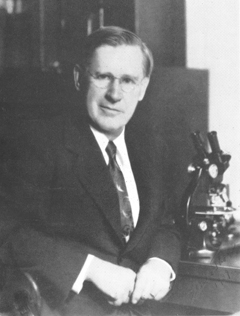Charles Thom
| Charles Thom | |
|---|---|
 |
|
| Born |
November 11, 1872 Minonk, Illinois, United States |
| Died | May 24, 1956 (aged 83) Port Jefferson, New York, United States |
| Resting place | Connecticut |
| Residence | United States |
| Fields |
|
| Alma mater | University of Missouri |
| Doctoral advisor | Howard Ayers |
| Known for |
|
| Author abbrev. (botany) | Thom. |
Charles Thom (November 11, 1872 – May 24, 1956) was an American microbiologist and mycologist. Born and raised in Illinois, he received his PhD from the University of Missouri, the first such degree awarded by that institution. He was best known for his work on the microbiology of dairy products and soil fungi, and in particular his research into the genera Aspergillus and Penicillium. His work influenced the establishment of standards for food handling and processing in the USA. He pioneered the use of culture media to grow microorganisms, and, with food chemist James N. Currie, developed a process to mass-produce citric acid using Aspergillus. Thom played an important role in the development of penicillin in World War II.
Thom was born in Minonk, Illinois in 1872, the fifth of six boys. His parents were Angus Sutherland Thom and Louisa (Herick) Thom, Scottish/Irish farmers who had settled in Illinois shortly before the American Civil War. Charles Thom was raised in a strongly religious household; his father was an elder in the Presbyterian church. Thom upheld Presbyterian values throughout his life, kept active in church affairs, and became a staunch prohibitionist. His early years spent working on his father's farm instilled the value of a strong work ethic, and first-hand knowledge of agricultural practices that would prove useful in his later career.
After graduating from high school, Thom attended Lake Forest Academy, a preparatory institution for college, in 1889. He earned a bachelor's degree from Lake Forest College in 1895. The next year he spent as a science teacher in a Danville high school, before returning to Lake Forest College to receive his Master's degree in 1897. In 1899, working under the supervision of Howard Ayers, he received his PhD from the University of Missouri on the topic of fertilization in the ferns Aspidium and Adiantum. This was the first doctorate awarded by that institution. Thom married Ethel Winifred Slater in 1906, with whom he had three children (one died during childbirth). Ethel Thom died in October 1942, shortly before his retirement. In 1944 he remarried, to Charlotte J. Bayles, with whom he lived until her death. Thom died two years after Charlotte at his home in Port Jefferson, New York, on May 24, 1956.
...
Wikipedia
